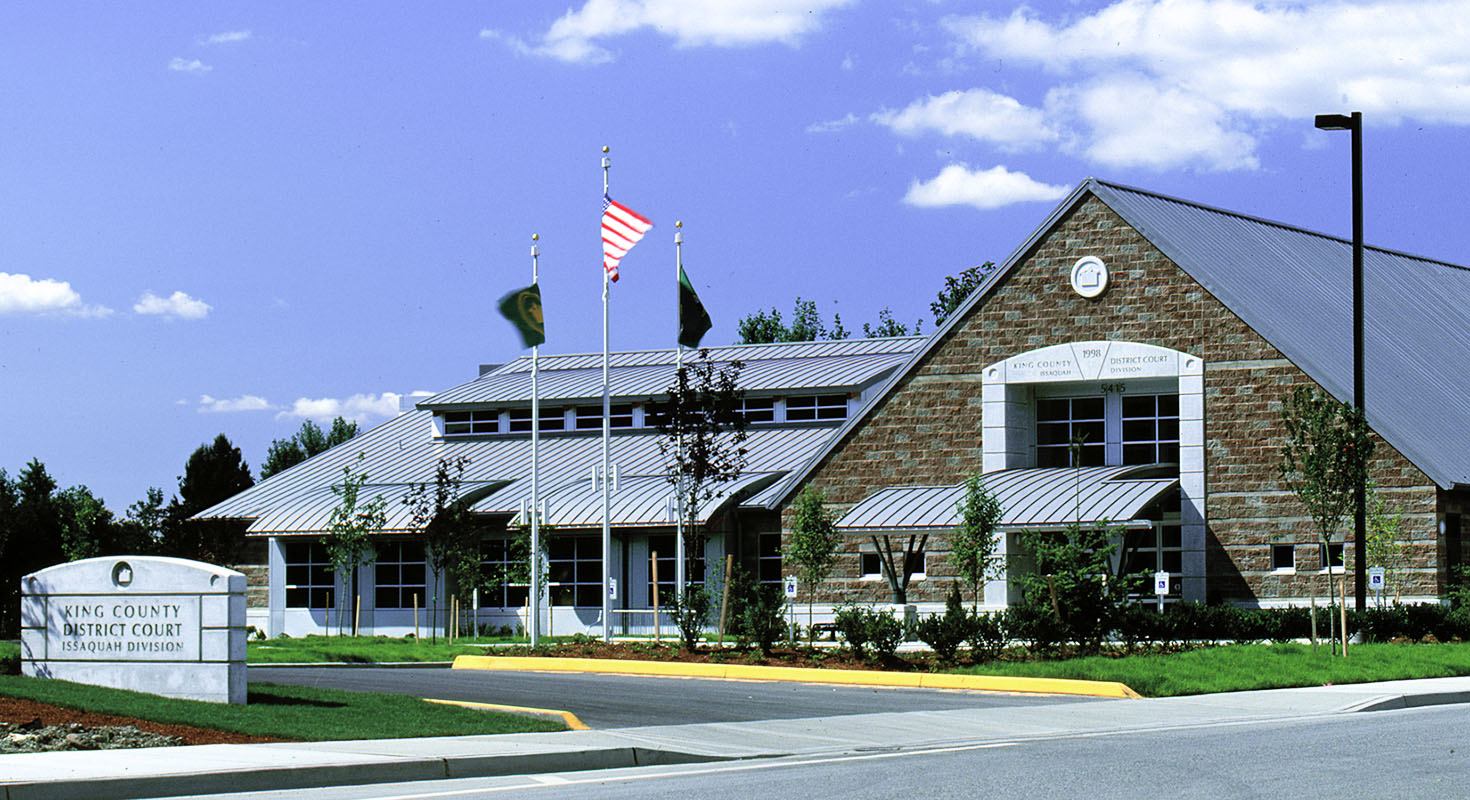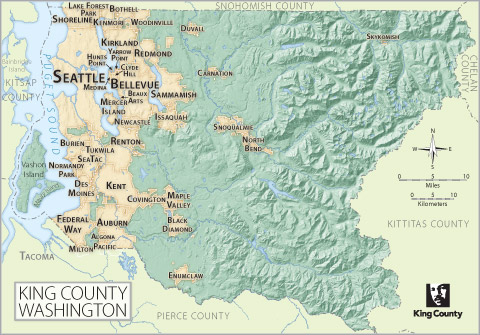Restraining Orders in the King County, Washington
Recently updated on June 7th, 2025 at 02:03 am
King County
King County which includes Seattle, Kent, Bellevue, Federal Way, Kirkland, Redmond, Auburn, Burien, Shoreline. These cities house campuses of major corporations such as Microsoft, Amazon, and universities such as University of Washington, Seattle University, and many more follow the same Washington law on Domestic Violence Protection Orders as the rest of the counties in Washington
The court forms needed are published on the Administrative Office of the Courts website which apply to the entire state. However, King County Courts along with other counties some times have additional county specific changes to the Washington forms, and also introduce additional county specific cover sheets.
Where is your protection (restraining) order case filed in the King County
The forms are filled and to be filed at one of these locations depending on where the victim lives or where the abuse occurred.
If you begin a case using the button on the upper right then your court location will be determined based on your responses.
Superior Courts
1 King County Superior Court in Seattle downtown.
In case you are filing at Superior Court, then areas north of the I-90 fall in the jurisdiction of the Seattle location.
2. King County Superior Court in Kent
Maleng Regional Justice Center (MRJC) 401 4th Ave N, Kent, WA 98032
In case you are filing at Superior Court, then areas south of the I-90 fall in the jurisdiction of the Kent location.
3. King County District Court, Auburn
340 E Main St 101 Auburn, WA 98002

4. King County District Court, Bellevue
1309 114th Ave SE #100, Bellevue, WA 98004
5. King County District Court, Burien
601 S.W. 149th St. Burien, WA 98166

6. King County District Court, Issaquah
5415 220th Ave. S.E. Issaquah, WA 98029-6839

7. King County District Court, Redmond
8601 160th Ave NE, Redmond, WA 98052
8. King County District Court, Shoreline
18050 Meridian Ave N, Shoreline, WA 98133

9. King County District Court, Kent
MRJC Office, 1A 401 4th Ave. N. Kent, WA 98032 (in the same building as the Superior Court)
10. King County District Court, Vashon
10011 S.W. Bank Road Vashon, WA 98070
Situations where Domestic Violence Protection Orders apply in Washington
There are a few different types of protection (restraining) orders and typically only one of them may apply to your situation. The first step is to see if any of the different types of protection (restraining) order applies to your situation or is remotely related as that might help you decide whether to apply .
The types are:

Domestic Violence is for situations involving romantic partners, ex-es, dating partners, roommates and family members when one person hurts the other physically, sexually or even emotionally by blackmailing or by being controlling. What is the legal definition of Domestic Violence in the Washington State.
Example 1: Husband is sexually and verbally abusive, and controlling
My husband doesn’t allow me the option to say no to sex, and often that warning is not explicit but I know bad things will happen if I say no such as bullying, threats and immense tension. As a couple we have been having sex everyday for nearly two decades now. He verbally abuses me by calling me a whore if I don’t sleep with him. During this time he is intoxicated so I am fearful of having a discussion as his anger will quickly get out of control, and he will hurl things at home thereby inducing more fear in me. Such behavior has been going on for over a decade now so I am not sure about the date of the first incident now. One day I very carefully chose my words and mentioned that maybe we are not a right fit, and should seek counseling. He was enraged and threated me that he will utterly destroy me, my work reputation, and expose some minor things I did to the immigration authorities. Since about six months, I have been sleeping in a separate room. He comes there routinely and tries to sleep with me forcefully. Often times I feel that if I resist, or decline his advances that my reputation, our property, or even me life will me in danger. I feel little, humiliated and disgusted with myself.
Example 2: Boyfriend blackmails and destroys property to control and induce fear
Today, Michael was armed with a pistol and seemed to be under the influence of an unidentified substance. He made threats to create false narratives with the aim of jeopardizing my 28-year accounting career, stating he would falsely accuse me of engaging in illegal financial activities. His menacing statement, “if you mess with me, I’ll retaliate,” was accompanied by destructive actions, such as damaging property in my home, including creating a hole in the wall. Michael’s behavior becomes particularly alarming when he is under the influence of drugs.
Example 3: Ex-boyfriend stalks
Jenna’s ex-boyfriend shows up at Jenna’s work unexpectedly and drives around. Jenna is fearful, and had earlier clearly asked him to leave her alone.
Situations where other Protection Orders apply in Washington
 Antiharassment applies to situations involving repeated irritating behavior, stalking, abuse, or threatened by someone you are not as close to as is required under domestic violence cases, like a neighbor, or more distant family members like cousins, aunts or uncles, or nieces or nephews.
Antiharassment applies to situations involving repeated irritating behavior, stalking, abuse, or threatened by someone you are not as close to as is required under domestic violence cases, like a neighbor, or more distant family members like cousins, aunts or uncles, or nieces or nephews.
 Vulnerable Adult: A senior citizen (or an adult who cannot function independently) is being abused by a caretaker, neighbor or child. These are also used by Adult Protective Services.
Vulnerable Adult: A senior citizen (or an adult who cannot function independently) is being abused by a caretaker, neighbor or child. These are also used by Adult Protective Services.
 Extreme (Firearm) Risk: Typically, a police officer or sheriff who thinks someone might hurt themselves or someone else with a gun. This can stop that person from buying or owning a gun. It can’t order them to stay away from someone.
Extreme (Firearm) Risk: Typically, a police officer or sheriff who thinks someone might hurt themselves or someone else with a gun. This can stop that person from buying or owning a gun. It can’t order them to stay away from someone.
 Stalking: An employer usually requests these to protect their employee(s) from a person who has stalked, harassed, been violent or threatened violence at the workplace.
Stalking: An employer usually requests these to protect their employee(s) from a person who has stalked, harassed, been violent or threatened violence at the workplace.
 Sexual Assault involves involving unwanted sexual conduct by someone who is not a romantic partner or an ex- or a roommate or a member of the victim’s family or household. This is also used as an added protection in criminal cases so in case the charges are dropped by the state, the victim has some basic protection via this protection order.
Sexual Assault involves involving unwanted sexual conduct by someone who is not a romantic partner or an ex- or a roommate or a member of the victim’s family or household. This is also used as an added protection in criminal cases so in case the charges are dropped by the state, the victim has some basic protection via this protection order.
Still Unsure ?
Answer few questions anonymously to see which one is suitable
How Protection (restraining) Orders Solve the Problem
The purpose of a protection (restraining) order is to restrict the contact or proximity of one person (the respondent or alleged perpetrator) to another person (the petitioner or victim) in order to ensure the safety and well-being of the petitioner.
The specific terms of a protection (restraining) order can vary depending on the circumstances of the case e.g. if the people live together then it might require one party to vacate the place.
Typically, a protection (restraining) order may prohibit the respondent from
- Approaching or contacting the petitioner including via text or social media
- Staying away from the usual places petitioner is at such as home, work or school
- Prohibit stalking, or surveillance of any kind
- In situations where they lived together, provide custody or access to
- Children
- Pets
- Important documents
- Personal items such as clothes, medications, cell phones
- Cars
- Extending the protections to others living with the petitioner
Here’s the top three findings from a study on domestic violence and protection (restraining) orders from the University of New Hampshire
 Reduce Violence
Reduce Violence
Civil protective orders (such as a DVRO) are effective in reducing partner violence for many women. For half the women in the sample, a protective order stopped the violence. For the other half, the orders significantly reduced violence and abuse.
Cost Effective
They are a relatively low-cost solution, particularly when compared with the social and personal costs of partner violence.
Urban Vs. Rural
The impact of civil protective orders on reducing violence and abuse did not differ for rural and urban women. In rural areas where resources and services for partner violence may be more limited, the protection (restraining) orders hold greater importance.
Process for Protection (restraining) Orders
Step 1: Gather evidence to support your case
The first step is to gather the evidence to support your case. The fallowing are considered as evidence of domestic violence
Evidence Type 1: Pending Criminal Case
Judges are also more likely to issue an order if there is an ongoing criminal case, therefore it’s important to call such cases out when seeking a temporary protection (restraining) order.
When a judge sees that there’s a criminal case happening, they might think it means the police or the district attorney are pretty sure they can prove the crime happened.
Examples of evidence are:
Evidence Type 2: Photos of violence, injuries, damage
These are the most common types of evidence submitted. These can be photos of victim’s injuries inflicted by the abuser. It is helpful to add photos next to the related incident description to help create a complete picture for the judge.
Evidence Type 3: Print outs of messages, emails or transcripts of voicemail
You can take screenshots of text messages and attach them. Similarly you can print emails and attach them as pictures or PDF files. While in most cases you cannot submit digital files such as
Evidence Type 4: 911 Calls
Rather than just saying you called 911 or any specific hotline, you can make your case stronger by listing the following items
- The number dialed in case of the domestic hotline
- The date and time (or approximate date and time) when the call was made
- Who made the call
- What was reported on the call
- Any specific details of the person who answer the 911 call e.g. male/female voice
Evidence Type 5: Medical Records
.You can attach documentation of previous medical emergencies or injuries that resulted from the actions of the abuser. These could be hospital visit records, print outs from your hospital portal (E.g. mychart) showing details of your visit.
Evidence Type 6: Police reports
You can attach a copy of the police reports filed against abuser for domestic violence.
Evidence Type 7: Testimony
- A testimony from a witness. The witness can be anyone such as a family member, neighbor a co-worker or a bystander. The testimony is just an essay written describing the incidents witnessed, with as many specifics as possible.
Step 2: Prepare King County court forms
Click one of the green button on the right to create these forms for free online →.
In order to apply for a civil protection order, you need to fill and submit a specific set of official Washington court forms with some cover sheets added by the King County courts.
The most important form is the petition, and it’s called Petition for Protection Order
[pdf-embedder url=”https://legalatoms.com/wp-content/uploads/PO-001-Petition-for-Protection-Order_2023_07.pdf” title=”PO 001 Petition for Protection Order” width=”500″]
The complete set of documents is at the Washington Courts website. While these forms are used in most courts, certain courts use modified versions of these forms, and its important to uses those versions.
 Tip: You can check your local court’s website to see the exact versions and set of court forms needed. You need to prepare these forms. Courts also offers a free self help center where you can take forms. Alternatively you can use a free website such as LegalAtoms to prepare the protection (restraining) orders paperwork online.
Tip: You can check your local court’s website to see the exact versions and set of court forms needed. You need to prepare these forms. Courts also offers a free self help center where you can take forms. Alternatively you can use a free website such as LegalAtoms to prepare the protection (restraining) orders paperwork online.
Nothing happens until you file the forms. So its a good idea to step through the forms even if you think you don’t plan to file for a protection order right now, to get
You can then file them online when you’ve thought through all aspects. There are special protections for victims, and you’re protected even if your immigration status is undocumented in United States.
Step 3: E-File the Court Forms
Typically these are filed at your county’s Superior Courts or District Court. Some of these courts are also called Family Justice Center.
Step 4: Wait for a King County Judge to Issue a Temporary Order
Depending on the facts and evidence presented, a Judge can issue a protection (restraining) order with immediate effect until the hearing, called an Emergency Temporary Order. In relatively less risky situations, a temporary order is issued in a few days.
If there are no grounds or if the application is incomplete or the jurisdiction is incorrect the application may be rejected.
The temporary order is only valid for about 3 weeks which is the amount of time until the hearing. If the hearing is delayed for any reason, you need to check with the court to ensure the temporary order is renewed until the hearing.
Step 5: Law Enforcement will Serve the abuser
- Clerk would have the abuser served by law enforcement. You don’t need to do anything in this case
- Clerk would give you a packet of temporary order and other documents, and you will have it formally served via another adult or legal courier to the abuser
- In some cases such as when the respondent address is unknown, a complete set of Temporary Order and supporting documents called the “911– Packet“ is handed to you. This is handy e.g. in case there is a confrontation with the abuser and cops get called, the cops can hand over physically the 911–packet to the abuser.
Step 6: Present Evidence in a Court Hearing
Attend a hearing: The court holds a hearing within a couple of weeks where the evidence is examined. If there is sufficient supporting evidence as determined by a Judge, a full protection (restraining) order is issued. At this point it becomes a crime for the abuser to break the conditions of the protection (restraining) order.
Step 7. Collect the Final Order
After the hearing, a final order may be issued. You can take a paper copy of the order with you. The order is typically valid for five years.
Legal Definition of Domestic Violence
The definition was updated in 2021 to include more subtle abuses. It is important because a protection order will be issued if the abuser’s behavior is shown to meet the definition.

As per Revised Code of Washington, R.C.W., § 7.105.010 (9) “Domestic violence” means:
(a) Physical harm, bodily injury, assault, or the infliction of fear of physical harm, bodily injury, or assault; nonconsensual sexual conduct or nonconsensual sexual penetration; coercive control; unlawful harassment; or stalking of one intimate partner by another intimate partner; or
(b) Physical harm, bodily injury, assault, or the infliction of fear of physical harm, bodily injury, or assault; nonconsensual sexual conduct or nonconsensual sexual penetration; coercive control; unlawful harassment; or stalking of one family or household member by another family or household member.
(20) “Intimate partner” means:
(a) Spouses or domestic partners;
(b) former spouses or former domestic partners;
(c) persons who have a child in common regardless of whether they have been married or have lived together at any time, unless the child is conceived through sexual assault; or
(d) persons who have or have had a dating relationship where both persons are at least 13 years of age or older.
Who can file the Civil Protection
(Restraining) Order case and for whom
For all civil protection orders, the case can be filed by someone (called petitioner) who is 15 years or older for all civil protection orders. Here are the situations:
For Domestic Violence Protection Order (DVPO)
 Self: A petitioner over can petition for himself/herself
Self: A petitioner over can petition for himself/herself

For Minors: A petitioner can file on behalf of minors who are family or household member. The petitioner must be minor’s choice and safeguard minor’s interests.
 For Vulnerable Adults: Petitioner can file for vulnerable adults who are family or household members
For Vulnerable Adults: Petitioner can file for vulnerable adults who are family or household members
For Antiharassment Protection Order (AHPO), Sexual Assault Protection Order (SAPO) and Stalking Protection Order (SPO)
 Self: A petitioner over can petition for himself/herself
Self: A petitioner over can petition for himself/herself

For Minor: A parent, legal guardian, or custodian can file for a minor
 For Vulnerable Adult: for a vulnerable adult or another adult who cannot petition himself/herself due to age, disability accessibility . The petitioner needs to demonstrate to the court’s satisfaction in a written affidavit that the petitioner is interested in the adult’s well-being.
For Vulnerable Adult: for a vulnerable adult or another adult who cannot petition himself/herself due to age, disability accessibility . The petitioner needs to demonstrate to the court’s satisfaction in a written affidavit that the petitioner is interested in the adult’s well-being.
Restrictions You can Ask for

Stay Away From You: Abuser would have to stay at least 100 yards away from you, your children and locations you request such as your work

Hand over Vehicles: Get access to cars held by the abuser

Not to Post Your Private Images: Take down, delete, and do not distribute intimate images of a protected person, as defined in RCW 9A.86.010.

Not to Contact You Not to contact you via phone or text or mutual friends
 Move out Abuser may be forced to vacate the residence shared with the victim
Move out Abuser may be forced to vacate the residence shared with the victim
 Restrict Abusive Litigation: This is to prevent the misuse of the legal system to harass, intimidate, or burden you.
Restrict Abusive Litigation: This is to prevent the misuse of the legal system to harass, intimidate, or burden you.
 Not to Stalk You: Not stalk you or your loved ones, including online stalking or surveillance such as on your accounts on Facebook or other social media.
Not to Stalk You: Not stalk you or your loved ones, including online stalking or surveillance such as on your accounts on Facebook or other social media.

Hand over personal items: Such as passport, medications, clothes. This would be applicable if you were living together up to now.
 Get Treatment for Drugs, Mental Health And Sex Offender: You can request the abuser to seek treatment for alcoholism, drug use, domestic violence abuse (RCW 43.20A.735) or sex offender (RCW 18.155.070)
Get Treatment for Drugs, Mental Health And Sex Offender: You can request the abuser to seek treatment for alcoholism, drug use, domestic violence abuse (RCW 43.20A.735) or sex offender (RCW 18.155.070)
Your Costs for Getting a Protection (restraining) Order
Some of the civil protection orders have no cost, owing to their use in protecting victims.
- Domestic Violence: $0 (FREE)
- Antiharassment: $ 53 – The fee is waived if the following are involved
- Stalking (as defined in RCW 9A.46.110)
- A hate crime (under RCW 9A.36.080(1)(c))
- A single act of violence or threat of violence (under RCW 7.105.010(35)(b)) OR
- From a person who has engaged in nonconsensual sex that constitutes a sex offense (as defined in RCW 9A.44.128)
- Sexual Assault: $0 (FREE)
- Stalking: $0 (FREE)
- Vulnerable Adult: $0 (FREE)
- Extreme Risk: $0 (FREE)
How long does the process take
If you file by noon at most courts, you can get a temporary protection order the same day as you file. Courts can have a cutoff of around 2 p.m. in most locations in the King County for the same day “Emergency” orders , so you need to file before then. Otherwise, the order would be issued the following day when courts open.
Courts are open Monday-Friday and closed on Saturday-Sunday.
The temporary order is valid until a formal hearing is held in which both parties need to be present. Typically a hearing is scheduled in 2 weeks of filing.
At the hearing a formal order may be issued
All Clerk’s Office locations are closed on Court Holidays.
Court Holiday |
Date |
Day of Week |
| Christmas Holiday | December 25, 2023 | Monday |
| New Year’s Day (observed) | January 1, 2024 | Monday |
| Martin Luther King Jr. Day | January 15, 2024 | Monday |
| Presidents’ Day | February 19, 2024 | Monday |
| Memorial Day | May 27, 2024 | Monday |
| Juneteenth | June 19, 2024 | Wednesday |
| Independence Day | July 4, 2024 | Thursday |
| Labor Day | September 2, 2024 | Monday |
| Veterans’ Day | November 11, 2024 | Monday |
| Thanksgiving Day | November 28, 2024 | Thursday |
| Native American Heritage Day | November 29, 2024 | Friday |
| Christmas Holiday | December 25, 2024 | Wednesday |
| New Year’s Day | January 1, 2025 | Wednesday |
Risks of Getting a Protection (restraining) Order
It is conceivable that following the submission of a civil protection order, the abuser particularly in domestic violence situations may react with anger due to the perceived loss of control over you and your household. In certain instances, the abuser may portray themselves as the victim and shift blame onto the actual victim they were mistreating.
The response of your abuser after the filing of a protection order is unpredictable. While a Domestic Violence Protection Order (DVPO) can provide legal protection, one should not automatically assume that it guarantees safety. The initial weeks post-filing can be particularly precarious, contingent on your abuser’s reaction.
Despite the safeguards intended by a DVPO, abusers may retaliate through various means, such as:
- Physical assault or violence
- Harming or taking away children
- Damaging jointly owned property
- Disregarding the order and persisting with threats, possibly through intermediaries
- Inflicting harm or causing harm to pets
- Harassing your loved ones for information
- Engaging in stalking behavior
- Initiating a retaliatory protection (restraining) order against you
- Spreading false information about you in court documents, online, or publicly
Following the submission of a domestic violence Protection order, it’s important to continuously assess your situation and prepare for the potential escalation of your case into more violent territory.
Calculating your risk level
 The Lethality Assessment Program (LAP) is a questionnaire used by law enforcement and other professionals, often in the context of domestic violence situations, to assess the risk of murder in cases involving intimate partner violence.
The Lethality Assessment Program (LAP) is a questionnaire used by law enforcement and other professionals, often in the context of domestic violence situations, to assess the risk of murder in cases involving intimate partner violence.
The questionnaire has about 20 questions designed to evaluate the severity and potential danger of a situation. These questions may cover aspects such as the presence of weapons, history of violence, threats of harm, and other factors that could indicate an increased risk of lethal violence.
- Has the physical violence increased in severity or frequency over the past year?
- Does the abuser own a gun? Or has he ever used a weapon against you or threatened you with a lethal weapon particularly a gun?
- Have you ever lived together? And if yes then have you left the abuser after living together during the past year?
- Is he unemployed?
- Has the abuser threatened to kill you? Do you believe he is capable of killing you?
- Does he threaten to harm your children?
- Does he ever try to choke/strangle you or cut off your breathing? . If yes to the previous question, has he done it more than once, or did it make you pass out or blackout or make you dizzy?
- Has he avoided being arrested for domestic violence?
- Do you have a child with the abuser which is not his
- Has he ever forced you to have sex when you did not wish to do so?
- Does he use illegal drugs? By drugs, I mean “uppers” or amphetamines, “meth”, speed, angel dust, cocaine, “crack”, street drugs or mixtures. . Is he an alcoholic or problem drinker?
- Does he control most or all of your daily activities? For instance, does he tell you who you can be friends with, when you can see your family, how much money you can use, or when you can take the car? 18. In reference to the previous question, do you let him control most or all of your activities?
- Is he violently and constantly jealous of you? (For instance, does he say: “If I can’t have you, no one can.”)
- Have you ever been pregnant by him? Have you ever been beaten by him while you were pregnant?
- Has he ever threatened or tried to commit suicide?
- Have you ever threatened or tried to commit suicide?
- Does he follow or spy on you, leave threatening notes or messages, destroy your property, or call you when you don’t want him to?
How many people file for Protection (restraining) Orders in the King County?
About 20,000 Civil Protection Orders including DVPO were filed in Washington in 2023 (Source: Administrative Office of the Courts). In March 2024 the numbers were consistent i.e. about 1700 (Source).
Related Posts
DVPO Meaning – Domestic Violence Protection Order
Recently updated on June 7th, 2025 at 02:16 amIn Washington State, DVPO stands for Domestic Violence Protection Order which is a civil court order designed to protect someone from harm or threats by a family member, intimate partner, or household member. A DVPO in Washington can order the abuser to: Stay away from the victim’s…
How a Landlord can serve the notice to tenant in Florida
Recently updated on June 6th, 2025 at 11:30 pmIn Florida, serving a notice to a tenant depends on the type of notice and the situation. Here’s a breakdown of common types of notices and how to serve them: 1. Notice of Nonpayment of Rent (3-Day Notice) This notice is served when a tenant has failed…
What Are the Risks of Filing for Eviction in Florida?
Recently updated on June 6th, 2025 at 06:14 pmHere are the risks of filing for Eviction in Florida 1. Dismissal of the CaseIf the eviction paperwork has errors — like listing the wrong amount of rent, failing to properly serve the notice, or missing deadlines — the court could dismiss your case. That means you…
How to Evict your Tenant in Florida for Not Paying Rent
Recently updated on June 6th, 2025 at 07:45 pmIf you have a tenant who is not paying rent, then you can legally evict the tenant by filing a legal case. An eviction case, also called an “unlawful detainer” case in Florida, is a legal action filed by a landlord to regain possession of a rental…









